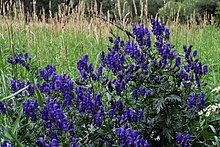Aconitum plicatum
| Aconitum plicatum | |
|---|---|

| |
| Aconitum plicatum | |
| Scientific classification | |
| Kingdom: | Plantae |
| Clade: | Tracheophytes |
| Clade: | Angiosperms |
| Clade: | Eudicots |
| Order: | Ranunculales |
| Family: | Ranunculaceae |
| Genus: | Aconitum |
| Species: | A. plicatum
|
| Binomial name | |
| Aconitum plicatum | |
| Synonyms | |
|
Aconitum amoenum[1] | |
Aconitum plicatum is a species of flowering plant in the buttercup family known by the common name garden monkshood.[3]
Distribution
This wildflower is native to Europe (Germany, Czech Republic, Poland and Slovakia).[4] Inhabited biotops include tall herbaceous vegetation and ravine forests.[1] Aconitum plicatum is also cultivated as ornamental plant.
Description
Aconitum plicatum is a tall spindly erect to scandent forb which is perennial from rhizomes. It has divided leaves. The flowering period extends primarily from July to September. The inflorescence is paniculate and simple or branched with a few or many side risps. The perigon is blue or purple. The perigon is densely hairy on the outside and inside by crooked trichomes. The peduncle is hairy or bare. The bracteoles are linear to triangular and bare. The plant reaches a stature height between 0.3 and 1.5 m. The pollination is done by insects (Bombus spec. and others). The fruits are pod-like follicles.[1] Aconitum plicatum is poisonous due the presence of alkaloids like aconitine.
Subspecies
Currently 2 subspecies are accepted:[2]
- Aconitum plicatum subsp. plicatum, autonym
- Aconitum plicatum subsp. sudeticum Mitka
References
External links
